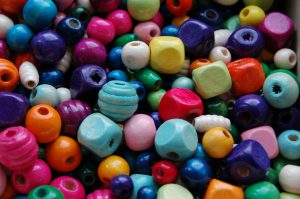
Bead collecting with Tia Marie Beading Studio.
Many people don’t think of beads as a collectible item, but one might be surprised at the vast amount of information that’s out there about beads. Most people who wear jewelry are not aware of the journey some of those beads took just to be a part of that finished piece.
Beads are manufactured in just about every country around the globe. The history of beads spans some 38,000 years to the present. Beads at one time, were a major commodity of the earlier trade routes. From boats to cargo aircraft, beads have traveled just as long as humans have migrated to different parts of the world.
Throughout time, beads have been used and displayed from everything such as body adornment to ranking within a particular clan or tribe of people. Beads have also been used to indicate the amount of wealth within the various social structures within any group or clan right up until the present.
Beads have been used as weapons, such as the beads from the warring states period beginning around 475-221 B.C.E. Warring states beads are generally called protruding eye beads. In fact, warring states beads were unearthed in the tombs of royalty from the warring states period. Beads have been used as currency in many societies, right up until the present.
Another example is the use of the Venetian glass beads use in trade from textiles to spices and the slave trade, commonly called Russian Blues. In fact, the famous Picard Collection lists the specific types of trade beads that were used for each specific item that was traded. Cargo ships transported hundreds of tons between Europe and Africa and trade routes that included many other parts of the world.
Beads are made from just about every type of material on the planet, ranging from bone (human and animal) to plastic, bakelite, resin, horn, freshwater and deep sea pearls, glass and porcelain.
There are different ways to manufacture beads:
- Carving is a method using a knife or specially designed tool to cut wood or soapstone in various shapes or round beads.
- Baked: The use of a specific material used to produce a specific bead type of bead is called Polymer Clay beads or Femo. This material can be used in a regular kitchen oven. Other materials such as porcelain and various clays must be baked in a Kiln due to the high temperatures required to make the finished product. Certain types of glass also require the use of a kiln as well. Beads can also be made from blown glass rods or molten glass.
- Stringing Material: Stringing materials are numerous and it is a good idea for the collector to learn the various types, especially when trying to pin down an approximation of age. Stringing material can sometimes be a good indication of when a particular piece was made and where it came from. Also, in some cases who may have made it!
A basic knowledge of tools are essential if you are a collector. Why? You as a collector should at least be able string a basic necklace and close it. Here are some common tools and their uses:
- Chain Nose Pliers, ideal for wrapping, crimping, opening jumprings and closing bead tips.
- Round Nose Pliers, used for making loops and filigree.
- Crimping Pliers, designed especially for crimp beads; they cinch a smooth crimp without unsightly sharp edges.
- Bead Cord Cutters, ideal for cutting close and completely flush (smooth). Use them on bead cord or very soft wire.
- Beading Awl, used by some beaders to knot close to beads and to untie stubborn knots.
- Bead Shapes: round, oval, square, rectangle, triangle, bi-cone, truncated bi-cone, barrel shape, polygonal bi-cone, etc.
These are just some of the things a bead collector must know in order to understand the basic concept of bead collecting as a whole. As a beader and collector, after more than 25 years of collecting, I still have a long way to go. Having worked in a bead store as both a sales person and manager, you are never in short demand for having knowledge of beading. My experience in the world of beading led me in part to complete my anthropology degree.
Visit Tia Marie Beading Studio right on Bloomfield Avenue for a taste of the bead collections Montclair has to offer!

You must be logged in to post a comment Login